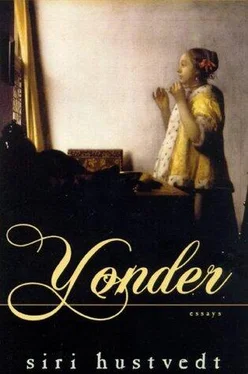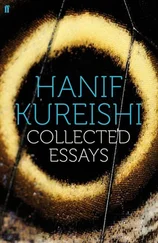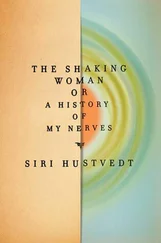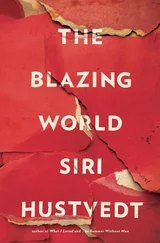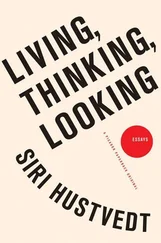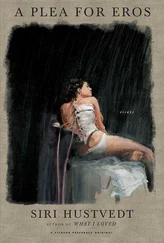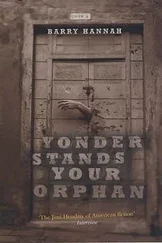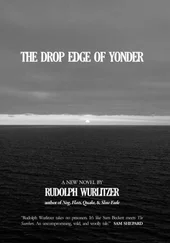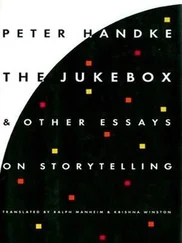His still lifes feel both undomestic and unfeminine. The food and objects he paints have been drained of their household functions, their semantic content. His objects appear denatured by the act of looking itself. Most people have experienced the odd sensation of estrangement that comes from looking long enough at a single object. For all of us there was a time before we knew what things were called, and then the world looked different. Cézanne’s still lifes are a rigorous effort to return to a vision unburdened by meaning. In a letter to a young poet in 1896, in which he complains about his growing fame, he writes, “… were it not that I am passionately fond of the contours of my own country, I should not be here.” 5The word contours is revealing. He does not say landscape. He says contours. Cézanne was searching for contours that would make us see again, in paint, what we have lost to language. The flatness or distortion of his canvases, the things that sometimes appear to float on the canvas, serve this alienation. It is as if these objects cannot be fully assimilated into their names. A part of them flees the word and lives in its contours.
In some way the project Cézanne set for himself is impossible. Because we can identify the things he paints, they cannot be stripped of meaning, and yet within this idea of seeing the world anew is also the proposition that paint is the medium in which to do it. Cézanne does not hide the existence of the brush but lets the strokes show, and by flattening his perspective, he tacitly acknowledges the canvas as a canvas. But Cézanne is not joking or teasing his viewer with some notion of art for art’s sake. The project on view in Cézanne’s still lifes and the sensuality of these objects is serious. Cézanne said again and again that he was interested in looking at nature, and he had a passion for discovery that was never completely satisfied. After all, light and air never rest. Cézanne painted the same place and the same things over and over again, in a constant search for the real through the imaginary. These still lifes show us mutability, not because we know that pears in the world rot but because these pears appear to exist within a larger continuum of nature that is in constant flux.
Cézanne, as is universally acknowledged, left a deep imprint on modern still life. Matisse’s still lifes bear the lessons of Cézanne. He, too, democratizes the visual field — flattening foreground and background into one, encouraging the spectator to take in one thing as much as another. But Matisse’s things are not denatured. In Still Life with Blue Tablecloth, I say to myself, There is a beautiful blue tablecloth with a coffeepot, a bowl of apples, and a green bottle illuminated by sunlight shining into the house. The coffeepot retains its connection to domestic life without this fact being particularly important. When I look at these still lifes by Matisse, I remember that ordinary things at home are also beautiful — a white pitcher on my red table, yellow roses in a blue vase. But looking at Matisse is not like looking at things at home. It is more like a vivid, very recent memory — the imprint that remains after you have closed your eyes to the image in the light.
Cubism adopts Cézanne’s idea of a new look at things without his devotion to the idea of unearthing an idea of the real — whatever the cubists may have claimed. Cubist still life canvases are lively, intellectual exercises that dissect ordinary vision in the interest of perceptual play. Their strength is in bringing an almost musical rhythm to the genre, so that the classical Dutch convention of showing instruments in still life becomes an evocation of music’s real movement, not only the idea of music as one of the fleeting pleasures we may indulge in before we die. And yet no matter how surprising these canvases must have seemed at the time, they are unmysterious. They articulate objects as much as Chardin does, but without the larger sense that this articulation is a pact of human fellowship. In cubism, even if the image is blasted to bits, a guitar is a guitar is a guitar, as long as we can detect its strings. Recognition is investigated but not subverted, as it is in Cézanne. Forceful, fun, and overtly masculine, cubism quotes the still life genre for its own purposes.
Classical still life has continued to thrive in the twentieth century. Giorgio Morandi’s miraculous bottles fall within the tabletop genre and tantalize the viewer with a strange dynamic between belief and doubt. His bottles suggest at once their identity as bottles in the world and an existence as spectral as Platonic shadows. If you look long enough at his paintings, the forms seem to change in their light — not sunlight but light from some imaginary source. As in Cotan, we cannot approach these images without awe. They reside in a space of otherness that may still be construed as a table.
Picasso, Klee, and Magritte all worked squarely inside the genre at times, but unlike Morandi, they did not find a home there. Philip Guston is the most recent artist I can think of whose use of still life was not a conservative nod to an old genre but a revolutionary gesture. In his late works, Guston does not refer back to a classic form but reinvents it. His drawings in particular — of shoes, books, brushes, pencils, ladders, cans, bottles, cigarettes, trash can lids, and nails — are unlike earlier still life and utterly different from the blank images of pop art that preceded his late work. Guston said himself that he was overwhelmed by a desire to draw objects, that he felt “relief and a strong need to cope with tangible things.” 6Still life in Guston seems to happen as part of a larger project that also includes the human figure and that bears a powerful relation to the body. An untitled drawing with a hand and a cigarette smoked backward (1967) feels to me very much like still life, except that, in this case, what is implied in Chardin — the gestures of a body — is included, not excluded. The gesture is also inverted, creating a comic complication unallowable in Chardin. The presence of a hand in Chardin’s work would disrupt its stillness. Here the hand seems to be another object in the world of objects. And while the things Chardin paints remind us of a universal domesticity, Guston’s pictures are personal images of a particular inner life that begin to gain resonance for all of us.
His images repeat themselves in a mobile creation of new meanings. It is as if he is in the business of inventing a new syntax of the banal. The shoe, for example, turns up again and again. The drawing of an untied boot from 1967 is infused with a sense of comic sadness, while The Door (1976), in which we see a crowd of boot and shoe soles almost entirely blocking an open door, communicates alarm and sexual discomfort. But the shoe is a labile entity, a true poetic form. In the remarkable Painter’s Forms (1972), a man’s profile with an opened mouth appears to spew forth, among other things, a cork, a boot, a sole, and a bottle. An infant’s first experience of the world is through its mouth, when it takes milk from its mother. For the first few years of life, in fact, the mouth is the primary organ of discovery. As all parents know, small children stick every object they can get their hands on into their mouths. But the mouth is also the place of speech, and Painter’s Forms is an image not of devouring but of expelling a vocabulary for painting.
In Painting, Smoking, Eating (1973), Guston links three human activities, the latter two of which are undeniably oral. And because all lists give equal status to the noun inside it, painting is associated with smoking and eating. There is no hand visible in this picture. A man lies under the covers in bed, a cigarette stuffed in his invisible mouth. Beside him are the materials of his art. Again we see shoe soles. But we are unable to tell whether these soles, some heavily outlined, some dimmer, are representations of footwear or the footwear itself. It does not matter. What we witness is not a man actively painting but the stillness of a head and its wakeful dreaming. This smoking head allows things to come into it, consciously or unconsciously, willy-nilly. The boots that fill that doorway remind me of nothing so much as my own semisleep dreams in which forms keep changing and then sometimes fix themselves into an unsettling picture dredged up from a secret place in my own psyche.
Читать дальше
